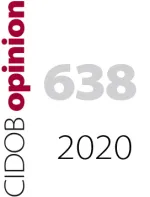Qualified solidarity

* This article was previously published in Público. This project has received funding from the European Union’s Horizon 2020 research and innovation programme under grant agreement No 822625 - ADMIGOV
After years of interminable meetings and never-concluded discussions on migration and asylum, Ursula von der Leyen's European Commission seemed determined to take a step forward. The New Pact on Migration and Asylum presented last Wednesday aims to advance the perpetually postponed reform of the Common European Asylum System, which will be integrated into a further-reaching proposal that "manages and normalises migration for the long term". Big claims for a plan that adds little to what already existed and worsens the problems that need solving.
The first doubt the proposal raises concerns the responsibility of member states. How can we manage a European space of free movement of people (the so-called Schengen area) without agreeing on shared responsibilities? When it comes to managing arrivals, some European Union governments (and not only the Visegrád ones) refuse to accept more responsibility – or any at all – while others (especially Greece, Italy and Spain) feel they have too much. That is the eternal problem. In August 2015 Angela Merkel declared that "Dublin doesn’t work". Five years on it still doesn’t work, in part because the Dublin system fails to equally distribute responsibility, leaving it to fall disproportionately on applicants' countries of first arrival (rather than destination).
The issue of responsibility is the great Achilles heel of European migration and asylum policy. The new proposal does not address it head on, difficult as that may be. Instead, seeking to please everyone, it gets tangled up in a solidarity that always comes qualified by an adjective (“voluntary” has now been replaced by “flexible”). Mandatory responsibility quotas are proposed, according to the capacity of each member state, but compliance with them is optional. This responsibility therefore results in "sponsoring return" or "sponsoring reception". Aid may be one-off or structural, and involvement in it direct or via logistical or financial support. It is difficult to imagine the actual architecture of this system of à la carte solidarity, in which even which preferred nationalities for deportation may be chosen. The indeterminacy of this qualified solidarity portends increased bureaucracy, disagreements between EU partners and higher economic costs in a system that may end up being more inefficient than the current one.
The other big question is how to reconcile border control with respect for human rights, international and European law, and that of member states. The pact proposes Europeanising border policies with rapid procedures that enable screening at the border and, in a few days, distinguish economic migrants from asylum seekers. It is hard to see how express procedures like these can guarantee a personalised evaluation of each asylum application, as established by the Geneva Convention. Although the pact begins by invoking a human and humane Europe, it does not specify how to combine border control (and its outsourcing to third countries) with guaranteeing basic principles such as non-refoulement, respect for life, and the obligation of member states to provide material living conditions for asylum seekers.
In the background of the Commission's latest proposal is Moria. Indeed, its presentation was brought forward following the fire in the refugee camp on the island of Lesbos. The message is that it must not happen again – Europe cannot afford it. Official statements explain Moria in terms of a dearth of European policies: Europeanising border policies will help avoid repeats. But how? According to this proposal, by combining express border procedures with a more effective returns policy that allows any person not considered to be a refugee to be deported. Returns are presented as the solution to the refugee camps and their indecent conditions. In 2015, migration policies in countries of origin and transit (and the so-called fight against traffickers) were presented as the solution to the deaths in the Mediterranean. In other words, by stopping them arriving you stop them dying. In both cases, what results is a mix-up of humanitarian and security measures.
The third major doubt the proposal raises relates to the starting points of the debate. According to European Commission President Ursula von der Leyen, the pact seeks to address one of the main challenges facing the EU today. But what exactly is the challenge? Last week’s Communication begins by recalling that the situation today is different to 2015, that irregular border crossings have been drastically reduced and that the issue now is to regulate immigration (understood as a structural part of Europe’s history, present and future) so that it contributes to our growth, innovation and social dynamism. But, after these emphatic assertions, the pact focuses primarily on border control. Are the 142,000 irregular border crossings of 2019 really one of the biggest problems facing a Europe of over 500 million inhabitants through whose airports more than two million immigrants legally enter every year? Or are we all succumbing to a mirage in which Europe continues to see hundreds of thousands of migrants waiting to leap across its borders?
The European Commission seemed to be taking a step forward but, in the end, its proposal is a case of everything changing (starting with the Dublin Regulation itself) so that everything stays the same. Ultimately, who we are does not change and when it comes to migration we are a divided, mistrustful and suspicious political community, where the common has been replaced by the defence of what is ours, where commitments do not outlast momentary dispositions, and where solidarity always comes after an adjective.
Keywords: migration, asylum, EU, Schengen, securitization, externalization, Dublin Regulation, Moria, refugees
E-ISSN: 2013-4428
D.L.: B-8439-2012